Good evening visitors from the �blogosphere”…… I must admit, that�s a new term that I�ve learned and added to my vocabulary this week lol!
I hope this post finds you well.
I�d like to share with you highlights from my visit to the Ges�, the Mother Church of the Jesuits, located here in Rome. I also thought it would be fitting, in light of my visit to the Ges�, to take this opportunity to share with you some reflections of a Homily that I delivered to the Jesuit Community at Boston College, marking the Feast of Saint Ignatius. In 1863, Boston College became the 11th Jesuit College to be established in the United States.
I�d like to share the following reflections with you:
The Feast of Saint Ignatius
If Ralph Kramden would have ever followed through with his idle threat of sending his beloved wife Alice to the moon, Alice would have discovered that thirty-five of the craters on the surface of the moon are named for Jesuits. 🙂 Many of them undoubtedly sent there by provincials.
I assure you that although our communities were founded at the same time and we have had a cup of coffee named after us — there are no craters on the moon named for Capuchins — not even a speed bump. lol! You can tell I am consumed with envy.
William Crashaw touted the fact that thanks to Luther and Calvin �the Romish Church, that scarlet whore, had fallen on hard times �her cup of abominations was almost drunk up but then the Jesuits had made their entrance, flying like locusts out of the bottomless pit, to repair the ruins of the Romish Church and to fill her golden cup with a new supply of spiritual fornications.�
John Adams, another admirer of the Jesuits wrote to Thomas Jefferson �I do not like the late resurrection of the Jesuits. Shall we not have swarms of them here, in as many shapes and disguises as ever a gypsy king assumed. If any congregation of men could merit eternal perdition on earth and in hell, it is this company of Loyola.�
The Gospel warns us that if they hated Jesus they will certainly hate Jesus� companions. But it is important to be hated for the right reasons. Hated because of our love for Christ and His Church. Hated because we raise our voice on behalf of the poor and the oppressed.
It was my privilege to be at the Puella Conference in 1979. There I met Fr. Pedro Arrupe S.J., the General of the Jesuits. This intrepid missionary who cared for the survivors of the atomic bomb in Nagasaki was asked if he was going to withdraw the Jesuits from El Salvador because there were death threats. He replied that quite to the contrary he was going to send more Jesuits to El Salvador. Spoken like another Basque Jesuit, Ignatius himself.
The role of the religious in the Church is to be a prophetic voice, but we must avoid the danger of being false prophets, and never allow ourselves to be supernumeraries of the dominant secularist culture always anxious to reward false prophets. More than ever we need religious who are convinced that the witness of our vows, poverty, chastity, obedience challenge the human heart where we tend to be more selfish in the areas of sexuality, of possessions and power. These truths will set us free and lead to happiness and to God.
As religious we must forcefully and boldly proclaim that the Gospel of Jesus is the story of the world not some appendix, excess luggage. As Weigel has stated, the great problem is that the world does not know its own story. The Gospel of Jesus Christ is not an imposition upon the world but the proposal to the world of its own true story. For the Catholic Christian the world is not alien territory but a creation of love that has tragically alienated itself from its creator. The mission of the Church is to call the world home. And the sons of Ignatius are in a unique position to contribute to this mission. As you form young minds lead them to Christ, to Christ who is inviting, cajoling, urging, wooing � calling the world home to itself. It is not enough to have alumni who are rich and famous. We must form new generations of disciples who love the Lord and His Church and who embrace the costly grace of discipleship and who will use all their talents and resources to build a civilization of love.
I see what the Jesuits did for my Father and so many generations of Catholics. You taught them to be men of faith and prayer, men of the Church, men with a sense of mission: in their family life, and in their professional life and in the Church and in society.
Today�s world demands a new apologetic and too often we have teachers who rather than explain the Catholic Faith, apologize for it. We need less apologizing and more apologetics. In the face of so much cynicism the Church is depending on you to articulate the liberating truths of the Catholic Faith.
I never go to Rome without visiting the Church of the Ges�. There I often go to confession and visit the tomb of Ignatius. At the Ges� I pray for the Jesuit Order�for friends and for all Jesuits�we have over 300 in the Archdiocese. I kneel before the tomb and pray the Suscipe of Ignatius. �Tomad Senor y recibid mi libertad�.Take and receive all my liberty.� The first thing Ignatius offers the Lord is his freedom.
The culture of death is seducing our people with the golden calf of freedom. Real freedom is found in the sacrificial self-giving of the Suscipe.
All that I have and possess is a gift and now I give it back to you.
To thee O Lord I return it. All is Thine.
Dispose of it wholly according to Thy will.
Give me only Thy Love and thy Grace,
that is enough for me. (St. Ignatius of Loyola)
My prayer is that God will raise up in the Church many holy sons of St. Ignatius and that they will teach this sacrificial love to our people – the unum recessarium – that God�s love and grace are enough.
To live a life in grace and in God�s love is the only success that counts. No other religious community has the resources, human, intellectual, spiritual, material that you (the Jesuits) have. You must not pass up the opportunities to give a serious faith formation to new generations of Catholics – who came to you with an unprecedented religious illiteracy and immersed in a culture that is hostile to the Gospel, and even to the concept of the truth itself.
But even more than teachers we need witnesses who enunciate the Church�s teachings with conviction and live a life that invites others to discipleship. It is not easy. Ignatius� own vocation begins with a reversal, a great set back, a failure.
Ignatius� vocation began like St. Francis� after an ignominious defeat in battle. From Ignatius� bed of pain comes the great charism of his life and ministry.
Wounded and fighting the boredom of a long convalescence, Ignatius asked for a copy of Amadis de Gaula, it was the Da Vinci Code of the day�.the book everyone was reading�but his sister-in-law brought him the Life of Christ and the lives of the Saints.
Reading the Life of Christ, Ignatius falls in love with the Lord. His conversion leads him to Manresa where he devoured the Imitation of Christ and the spirit of the Devotio Moderna. Ignatius is truly focused on Jesus. It was not a fugamundi spirituality of earlier ages, but one that engages the world and sees there the venue for a life of grace and discipleship.
In today�s Gospel John the Baptist points out Christ to his disciples and they leave John to follow the Lamb of God. Ignatius did not strive to make personal followers but rather to lead people to the Lord and to act for the greater glory of God.
Ignatius is a seeker and the Lord invited him �to come and see�. His spiritual journey that included such intense prayer and fasting is a total conversion from self to God. Ignatius loved the Lord, our Blessed Mother, the Church and her sacraments.
In his profound experience of the interior life he left us a blue print for personal conversion and discernment of God�s will in his spiritual exercises. But the great treasure he left the Church was the Society of Jesus, men dedicated to serving Christ and the Church. In the great number of martyrs, like Edmund Champion, Paul Miki and Agustin Pro we find the heroic ideals of Ignatius lived out in the spiritual adventures of his sons.
One son who was close to Ignatius was Francis Xavier. Each December I relish the reading at Matins for his feast – the passionate letter he writes to Ignatius where he describes his frustration at the overwhelming task of teaching people about God and how to pray. Francis Xavier says he often thought of going to the great universities of Europe and everywhere crying out like a madman, riveting the attention of those with more learning than charity; �What a tragedy, how many souls are being shut of heaven and falling into hell thanks to you! I wish that they would work as hard at this as they do at their books, and so settle their account with God for their learning and the talents entrusted to them.�
If Ignatius and Francis were here I am sure they would echo these same sentiments to those entrusted with running our universities and Catholic schools. We need to lead people to the Lord, to teach them about the interior life, to help them sentire cum ecclesia, to inspire people to make a gift of ourselves to God, trusting indeed that His love and Grace are enough for us.
If we can help our students to discover God only then will they discover who they are and why we are here, and what we have to do with our lives.
You are Jesus companions – your vocation is to share that companionship with others. Teach them to pray. At Georgetown the Jesuit I always hear about is Father King who each night at 11:15 celebrates Mass for the students.
Ad Majorem Dei Gloriam – For the Greater Glory Of God
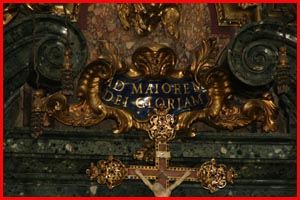
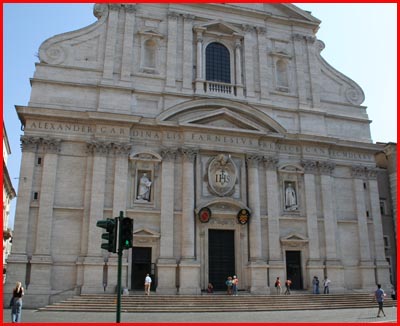
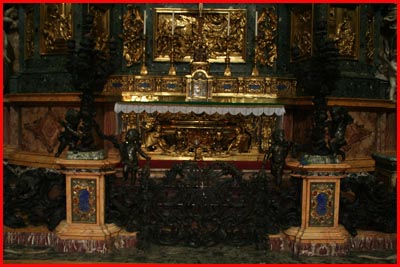
The Chapel of St. Ignatius. The tomb of St. Ignatius is located here. That striking blue gemstone you see around the chapel is called Lapis lazuli. The chapel was actually damaged during the French invasion and then later reconstructed. It�s said that Pope Puis VI may have been forced to melt some the original chapel’s silver to pay Napoleon as a result of the Treaty of Tolentino in 1797.
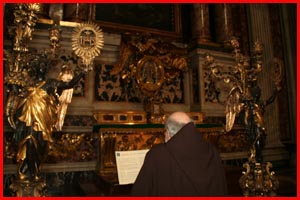
The Jesuit Church also has relics of St. Francis Xavier, who was a great missionary to Japan, India and China. He was one of St. Ignatius� first followers when he founded the Jesuits.
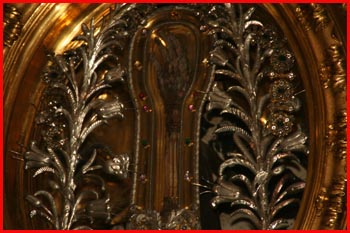
This golden reliquary holds the right arm of St. Francis Xavier�it�s the arm that was used to baptize many thousands of people in the missions.
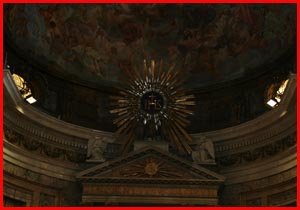
The Name Jesus is on the Jesuit crest, their symbol � �IHS� � The first three letters in Greek of the name �Jesus.� The IHS above is located under the work �Glory of the Mystical Lamb� in the Ges�.

The main altar at the Ges�.
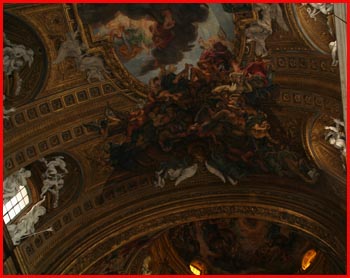
The magnificent fresco on the Ges��s ceiling was so masterfully created that it actually tricks your eye�.one has a difficult time determining whether it�s a painting or actually statues and sculptures adorning the ceiling.
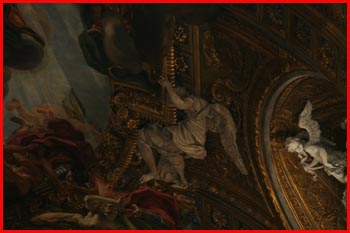

My eyes were indeed being tricked.
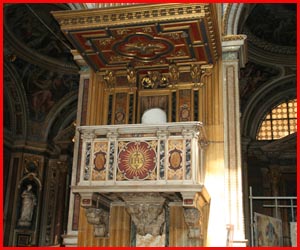
A pulpit elevated high over the Ges��s floor….before technological advances with microphones and sound amplification, the location of these pulpits helped priests preach to the flock.
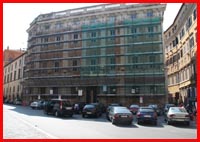
A bit of Italian political history: In the piazza in front of the Ges� and this building above, is where Italian Prime Minister Aldo Moro�s body was discovered after he had been kidnapped and murdered in 1978 by the Red Brigades, a militant group.
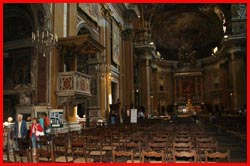
Well, I hope you enjoyed the highlights of the Ges�. The Mother Church of the Jesuits is really one of the most beautiful churches in Rome and I’m grateful for the opportunity to share it with you…and also the opportunity to share with you my reflections about St. Ignatius and the Jesuits.
Until my next post….
God Bless,
Cardinal Se�n
